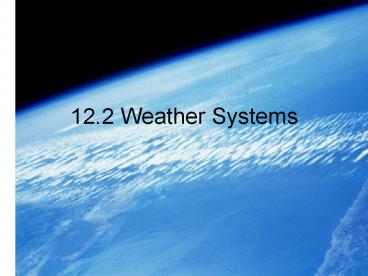12.2 Weather Systems PowerPoint PPT Presentation
1 / 30
Title: 12.2 Weather Systems
1
12.2 Weather Systems
2
Coriolis effect
- The Coriolis effect, which is a result of Earths
rotation, causes moving particles such as air to
be deflected to the right in the northern
hemisphere and to the left in the southern
hemisphere.
3
There are three basic zones, or wind systems, in
each hemisphere.
4
Trade Winds
- The trade winds, the first major wind zone, flows
at 30 north and south latitude, where air sinks,
warms, and returns to the equator in a westerly
direction.
30
0
5
Prevailing Westerlies
- The prevailing westerlies, the second major wind
zone, flows between 30 and 60 north and south
latitude in a circulation pattern opposite that
of the trade winds.
60
Prevailing Westerlies
30
Trade Winds
6
Polar Easterlies
- The polar easterlies, the third major wind zone,
lies between 60 latitude and the poles.
90
Prevailing Westerlies
60
Trade Winds
7
(No Transcript)
8
Jet streams
- Jet streams are narrow bands of high-altitude,
westerly winds that flow at speeds up to 185 km/h
at elevations of 10.7 km to 12.2 km.
9
(No Transcript)
10
Jet streams separate the wind systems from each
other
Prevailing Easterlies
90
Prevailing Westerlies
60
30
Trade Winds
0
11
(No Transcript)
12
Fronts
- A front is the narrow region separating two air
masses of different densities that are caused by
differences in temperature, pressure, and
humidity.
13
Cold Front
- In a cold front, cold, dense air displaces warm
air and forces the warm air up along a steep
front.
- Clouds, showers, and sometimes thunderstorms are
associated with cold fronts. - Represented by
14
(No Transcript)
15
(No Transcript)
16
Warm Front
- In a warm front, advancing warm air displaces
cold air.
- The warm air develops a gradual frontal slope
rather than a steep boundary. - A warm front is characterized by extensive
cloudiness and precipitation. - Represented by
17
(No Transcript)
18
(No Transcript)
19
Stationary Front
- A stationary front is the result of two air
masses meeting and neither advancing into the
others territory, stalling the boundary between
them.
- Stationary fronts seldom have extensive cloud
and heavy precipitation patterns. - Represented by
20
(No Transcript)
21
Occluded Front
- An occluded front is the result of a cold air
mass overtaking a warm front, wedging the warm
air upward.
- Precipitation is common on both sides of an
occluded front. - Represented by
22
(No Transcript)
23
(No Transcript)
24
(No Transcript)
25
High Pressure Systems
- In a high-pressure system, air sinks, so that
when it reaches Earths surface it spreads away
from the center. - The Coriolis effect causes the overall
circulation around a high-pressure center to
move in a clockwise direction in the northern
hemisphere.
26
Low Pressure Systems
- In a low-pressure systems, air rises, causing an
inward net flow toward the center and then
upward. - In contrast to air in a high-pressure system,
air in a low-pressure system in the northern
hemisphere moves in a counterclockwise
direction.
27
Wave Cyclone
- A wave cyclone, one of the main producers of
inclement weather in the middle latitudes,
usually begins along a stationary front.
28
(No Transcript)
29
(No Transcript)
30
(No Transcript)

